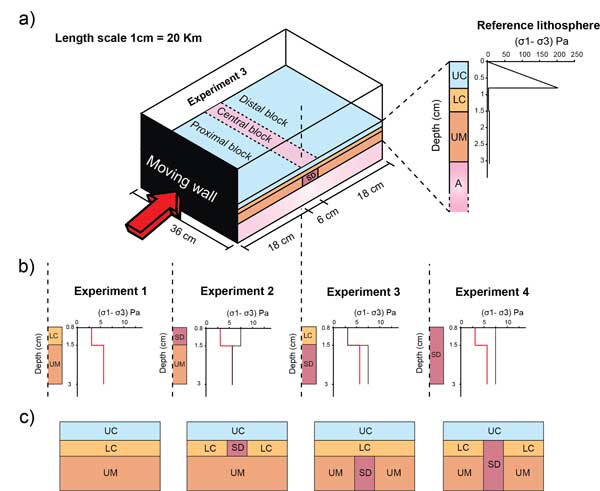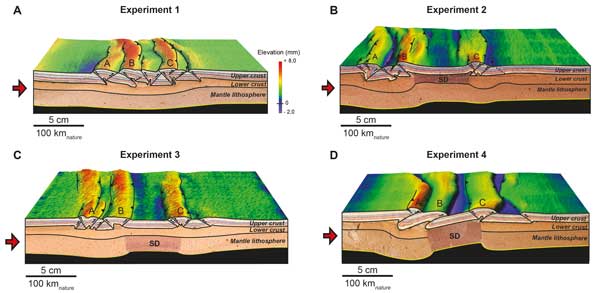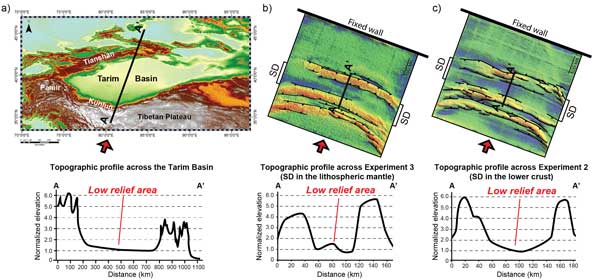|
Elisa Calignano1, Dimitrios Sokoutis1,2, Ernst Willingshofer1, Frédéric Gueydan1,3, Sierd Cloetingh1
1Faculty of Geosciences, Department of Earth Sciences, Utrecht University, Budapestlaan 4, PO Box 80021, 3508 TA Utrecht, The Netherlands;calignano.elisa@gmail.com ; D.Sokoutis@uu.nl ; E.Willingshofer@uu.nl ; frederic.gueydan@univ-montp2.fr ; S.A.P.L.Cloetingh@uu.nl
2Department of Geosciences, University of Oslo, PO Box 1047 Blindern, N-0316 Oslo, Norway
3Géosciences Montpellier, Université Montpellier 2, UMR CNRS/INSU 5243, Place Bataillon, CC60, 34093 Montpellier Cedex, France
This webpage is a summary of: Calignano, Elisa, Dimitrios Sokoutis, Ernst Willingshofer, Frédéric Gueydan and Sierd Cloetingh, Strain localization at the margins of strong lithospheric domains: Insights from analog models, Tectonics, 34, 396–412, Article first published online: 11 MAR 2015 | DOI: 10.1002/2014TC003756.
Introduction: intraplate deformation and strain localization
Tectonic plates are deformed mostly at their boundaries, where the highest strain rates and seismic activity occur. However, plate interiors can also show considerable non-rigid behaviour, as demonstrated by widespread seismicity and topography (Aitken et al., 2013). The localization of deformation in particular regions of plate interiors is intimately linked to lateral strength contrasts in the lithosphere (Audet & Bürgmann, 2011; Raimondo et al., 2014; Ranalli, 1997). In fact continents are composed of lithospheric domains that experienced different tectonic processes which modified the temperature and composition of crust and mantle resulting in weak or strong heterogeneities (Audet & Bürgmann, 2011; Ranalli, 1997; Tesauro et al., 2012). The analogue experiments presented in this webpage reproduce such lateral heterogeneity in lithosphere rheology and test its influence on strain localization and the geometry of intraplate mountain belts. In particular, the analogue models study the reactivation of a pre-existing "strong domain" (SD) embedded in the continental lithosphere. In nature strong lithospheric domains occur in different continental collisional systems and they are usually characterized by low strain rate and low relief with concentrated deformation and crustal thickening at their margins.
Experimental setup
We present four lithospheric-scale analogue models. In these, the depth of a high-viscosity domain is systematically varied, in order to identify characteristic deformation patterns and topography related to heterogeneities seated at different depth in the lithosphere.
The three-layer continental lithosphere is simulated with the superposition of different ductile materials (silicon putties) for the lithospheric mantle and lower crust, and brittle material (feldspar sand) as analogue for the upper crust (Figure 1), and rests on a high-density, low-viscosity fluid representing the asthenosphere. The models are constructed in a transparent Plexiglas tank equipped with an internal moving wall driven by an engine to simulate compression. Beside a reference model characterized by laterally uniform lithosphere (Experiment 1), all other experiments consist of three domains with different mechanical properties: a central block containing a mechanically stronger heterogeneity (SD) in the ductile part of the lithosphere is located between two blocks sharing the same lithospheric stratification as the reference model. The SD represents a region of reduced geothermal gradient and/or dry and/or more-mafic composition.

Figure 1: a) Experimental set-up: three-layer laterally heterogeneous continental lithosphere resting on a high-density, low-viscosity fluid representing the asthenosphere. Shortening is applied via the moving wall; b) representative strength profiles showing lateral variation in lithospheric strength at initial stage of deformation. Red lines represent the strength of the reference lithosphere in Experiments 1 to 4. Black lines represent the strong domain; c) schematic cross section showing the investigated vertical location of the strong domain.
UC: upper crust; LC: lower crust; UM: upper mantle; SD: strong domain; A: asthenosphere. Click here or on Figure for enlargement.
Experimental results: Strain localization at the margins of strong lithospheric domains
Compression of a laterally uniform lithosphere (Experiment 1) results in homogeneous strain distributed over a wide domain localized in the centre of the model (Figure 2a). Pop-up and pop-down structures develop in the brittle crust associated with a broad synform that forms in the ductile part of the lithosphere.
When an SD is introduced, deformation becomes localized at its vertical margins, where linear mountain belts and related lithospheric roots develop. When the lithosphere has an SD within the ductile lower crust, deformation in the brittle upper crust is accommodated by two main thrusts with opposite vergences (Figure 2b).
In contrast, when the SD is located in the ductile upper mantle, two symmetric pop-ups form at the boundaries of the central block and the Moho and the base of the lithosphere remain at shallower levels (Figure 2c). In both cases, despite the aforementioned differences, an undeformed region characterized by low elevation and topographic gradient becomes enclosed by high relief narrow belts developing along the boundaries of the SD.
With an SD covering the entire ductile lower crust and upper mantle of the central block, deformation is accommodated by forward thrusts rather than symmetric pop-ups and the SD is tilted towards the moving wall. This leads to the development of a central asymmetric basin with higher subsidence on the side of the applied convergence (Figure 2d).

Figure 2: Final geometry and interpreted structures after 20% bulk shotening illustrated by a representative cross section obtained by cutting the model after freezing. The DEM (Digital Elevation Model) was acquired using laser scanning. A. Experiment 1: uniform continental lithosphere; B. Experiment 2: SD in the lower crust; C. Experiment 3: SD in the ductile lithospheric mantle; D. Experiment 4: SD in the lower crust and ductile lithospheric mantle. Click here or on Figure for enlargement.
Implication for strain localization around the Tarim Basin (North-western China)
The Eurasian plate is a well-known example of intra-plate deformation associated with the Cainozoic India-Asia continental collision (Molnar & Tapponnier, 1975). Far-field deformation is characterized by uplifting orogenic belts, often bounding rigid and undeformed lithospheric blocks (e.g., the Tarim Basin) and widespread strike-slip tectonics (Cunningham, 2013; Molnar & Tapponnier, 1975). At the time of India-Asia continental collision, the pronounced lateral rheological heterogeneity between the Tarim craton and the composite and highly deformed basement of the Tianshan and Tibetan Plateau (Liu et al., 2015; Zhang et al., 2013) offered favourable conditions for strain localization (Clark & Royden, 2000; Neil & Houseman, 1997). As a result the interior of the Tarim Basin experienced little or no deformation, as indicated by reduced seismicity, low heat flow and the absence of major fault structures (Kao et al., 2001; Liu et al., 2015), while the Palaeozoic Tianshan and Tibetan blocks underwent renewed orogenesis. Previous studies interpreted steep topographic gradients flanking rigid blocks such as the Tarim Basin as resulting from oozing of lower crust around rigid obstacles (Clark & Royden, 2000).
Figure 3 shows a comparison of a topographic profile across the Tarim Basin and two best-fit experiments. The topography of the Tarim Basin (Figure 3a), characterized by a low relief area enclosed by high relief belts, is obtained both with a strong domain located in the lower crust and a strong domain located in the lithospheric mantle (Figure 3b & 3c). Our lithospheric-scale models successfully explain strain localization in intra-plate Eurasia induced by India-Asia collision and support a scenario where the strength contrast across the Tarim might be located at mantle depths.

Figure 3: Comparison of experimental results to the Tarim Basin. a) relief map of Tarim Basin (northwest China) and topographic profile along a cross section parallel to the India-Asia convergence (N21?E) (Wang et al., 2001); b) DEM and topographic profile along a cross section parallel to the convergence direction for Experiment 3; c) DEM and topographic profile along a cross section parallel to the convergence direction for Experiment 2. Elevation is normalized to the lowest elevation recorded in the low-relief area. The red arrows indicate the direction of convergence. Click here or on Figure for enlargement.
Conclusion
The analogue models presented here illustrate that a strong domain in continental lithosphere subject to compression induces pronounced strain localization. Narrow orogenic belts develop at the boundaries of the strong domain, delimiting a stable, low relief region, as exemplified in the Tarim Basin and surroundings.
References
-
Aitken, A.R.A., Raimondo, T., Capitanio, F.A., 2013. The intraplate character of supercontinent tectonics. Gondwana Research, 24, 807-814.
-
Audet, P., Bürgmann, R., 2011. Dominant role of tectonic inheritance in supercontinent cycles. Nature Geoscience, 4, 184-187.
-
Clark, M.K., Royden, L.H., 2000. Topographic ooze: Building the eastern margin of Tibet by lower crustal flow. Geology, 28, 703-706.
-
Cunningham, D., 2013. Mountain building processes in intracontinental oblique deformation belts: Lessons from the Gobi Corridor, Central Asia. Journal of Structural Geology, 46, 255-282.
-
Kao, H., Gao, R., Rau, R.-J., Shi, D., Chen, R.-Y., Guan, Y., Wu, F.T., 2001. Seismic image of the Tarim basin and its collision with Tibet. Geology, 29, 575-578.
-
Liu, S., Lei, X., Wang, L., 2015. New heat flow determination in northern Tarim Craton, northwest China. Geophysical Journal International, 200, 1196-1206.
-
Molnar, P., Tapponnier, P., 1975. Cenozoic Tectonics of Asia: Effects of a Continental Collision: Features of recent continental tectonics in Asia can be interpreted as results of the India-Eurasia collision. Science, 189, 419-426.
-
Neil, E.A., Houseman, G.A., 1997. Geodynamics of the Tarim Basin and the Tian Shan in central Asia. Tectonics, 16, 571-584.
-
Raimondo, T., Hand, M., Collins, W.J., 2014. Compressional intracontinental orogens: Ancient and modern perspectives. Earth-Science Reviews, 130, 128-153.
-
Ranalli, G., 1997. Rheology of the lithosphere in space and time. Geological Society, London, Special Publications, 121, 19-37.
-
Tesauro, M., Audet, P., Kaban, M.K., Bürgmann, R., Cloetingh, S., 2012. The effective elastic thickness of the continental lithosphere: Comparison between rheological and inverse approaches. Geochem. Geophys. Geosyst., 13.
-
Wang, Q., Zhang, P.-Z., Freymueller, J.T., Bilham, R., Larson, K.M., Lai, X.a., You, X., Niu, Z., Wu, J., Li, Y., Liu, J., Yang, Z., Chen, Q., 2001. Present-Day Crustal Deformation in China Constrained by Global Positioning System Measurements. Science, 294, 574-577.
-
Zhang, C.-L., Zou, H.-B., Li, H.-K., Wang, H.-Y., 2013. Tectonic framework and evolution of the Tarim Block in NW China. Gondwana Research, 23, 1306-1315.
last updated 9th
August, 2015 |
